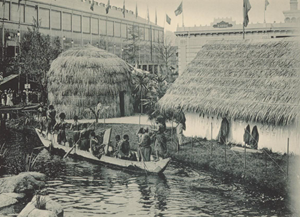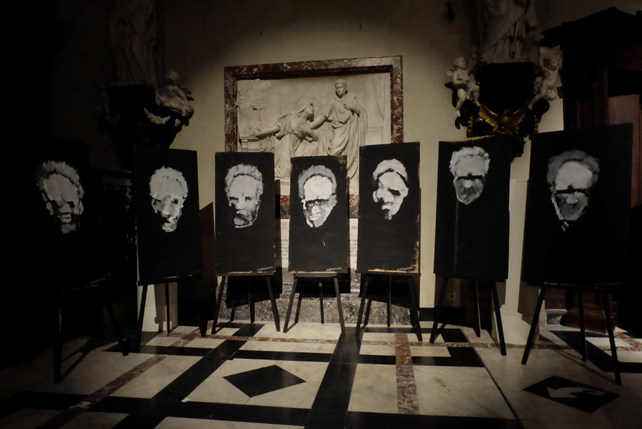
On 24 September, the Royal Museum of Fine Arts Antwerp was officially reopened by Flemish minister-president and minister of culture Jan Jambon. The museum announced a weekend of celebrations on the museum square. We find it inappropriate not to pay attention to the colonial shadow side of the square on the occasion of the reopening.
On 24 September, the Royal Museum of Fine Arts Antwerp was officially reopened by Flemish minister-president and minister of culture Jan Jambon. The museum announced a weekend of celebrations on the museum square. We find it inappropriate not to pay attention to the colonial shadow side of the square on the occasion of the reopening. We ask the Antwerp city council to finally work towards an official commemoration for the Congolese victims of the 1894 World Fair.
In 1885, the African continent was divided like a pie by European countries. Belgium's King Leopold II was given the vast Congo as private property. That same year, Antwerp organised its first World's Fair. These exhibitions were a way to show off European technical progress and products and people from the colonies. The Antwerp World's Fair was repeated in 1894 and 1930.
Human Zoo on museum square
As the museum reopens after an 11-year renovation, we draw attention to the 1894 World's Fair. Back then, 144 black people were taken away by boat from Congo for the Congo pavilion of the Antwerp World Expo. A recreated Congolese village stood on the museum square. Once they arrived at the Scheldekaai, the black men and women were exhibited like animals in a zoo. This degrading mise-en-scène and barbarism was part of the colonial propaganda that was supposed to present a primitive image of Africans 'to be civilised'. In the 19th and 20th centuries, several Western countries organised human zoos that were visited en masse. This degrading phenomenon was downright racist and still shapes stereotypes today.
 The 7 Dead of Antwerp by David Katshiunga
The 7 Dead of Antwerp by David Katshiunga
Until last year, the award-winning exhibition '100 x Congo. A century of Congolese art in Antwerp'. According to research by the museum, seven Congolese died at the World Expo. They were aged between 17 and 35 and lie with others in a mass grave in Schoonselhof cemetery. This is a forgotten tragedy in Antwerp's urban history.
Official commemoration
In recent years, Belgium has taken political steps to deal more critically with its colonial past. Several cities and municipalities in Flanders are opting for commemoration projects. We believe that Antwerp cannot be left behind. The city council should face up to Antwerp's colonial history and acknowledge the link between the port city's wealth and Congo. Indeed, Leopold II found loyal allies in Antwerp for his colonial project. Antwerp politicians and entrepreneurs shared in the huge profits from Congolese ivory and rubber. The two rubber companies ABIR and Anversoise were based in the city.
Since the summer, the connecting artwork 'The Long Hand' by Congolese artist Sammy Baloji has been showing off on the Scheldekaai. This is a prudent move by the city. But it is now time to move forward on the occasion of the museum's reopening by commemorating the victims of the human zoo - both those who were exhibited as well as those who died in Antwerp - in Antwerp. It is time to give the forgotten tragedy an official place in the city's remembrance policy almost 130 years after the fact. Place a commemorative plaque onthe museum square. Create an artistic place where city residents and visitors can come together and commemorate the Congolese. Proposals are on the table. They must now be taken seriously by the city council. And for that, we look especially to Mayor Bart De Wever and Alderwoman for Culture Nabilla Ait Daoud.
Initiators
Judith Elseviers, lawyer and decolonisation adviser
Nadia Nsayi, political scientist and author
Signatories
Bambi Ceuppens, researcher AfricaMuseum
Baudouin Mena Sebu, PhD student University of Antwerp
Ben Van Duppen, researcher University of Antwerp
Bitshilualua Kabeya, podcast host Menji and staff member decolonisation Avansa
Carolina Maciel de França, writer and performer
Charly Badibanga, host talkswithcharly
Chokri Ben Chikha, director Action Zoo Humain
Christophe Busch, criminologist
Dalilla Hermans, columnist, author and theatre maker
David Katshiunga, artist
David Van Reybrouck, writer
Don Pandzou, diversity expert and author
Fleur Pierets, writer
Frank Van Laeken, journalist and author
Georgine Dibua, coordinator Bakushinta
Gilles Mbiye-Beya, podcast host KoolcastSport
Guido Totté, former staff member City of Antwerp
Gunilla de Graef, lecturer in intercultural communication and researcher on inclusion
Guy Poppe, journalist
Henk de Smaele, professor University of Antwerp
Herman Van Goethem, Rector of the University of Antwerp
Hind Eljadid, word artist
Ikrame Kastit
Ish Ait Hamou, writer
Jeroen Malaise, professor Royal Conservatory of Antwerp
Jeroen Olyslaegers, writer
Jihad Van Puymbroeck, co-chairman Hand in Hand against Racism
Kevin Absillis, senior lecturer University of Antwerp
Kris Smet, former VRT journalist
Kristien Hemmerechts, writer
Kristel Driessens, researcher at Karel de Grote Hogeschool
Lies Van Assche, artist, DOEK vzw
Lies Busselen
Lieven Miguel Kandolo, co-chairman Hand in Hand against Racism and author
Marie Antoinette Kumudidi Walo, social worker
Marius Dekeyser, coordinator Hand in Hand against Racism
Marnix Beyen, historian University of Antwerp
Matthias De Groof, professor University of Antwerp and researcher University of Amsterdam
Mathieu Zana Etambala, guest professor University of Ghent
Michel Kiyombo & Sofie Cloet, Human Sense Project
Mostafa Benkerroum, actor and theatre maker
Nina Henkens, coordinator of Kif Kif
Nyanchama Okemwa, collaborator Hand in Hand against Racism
Olivia Umurerwa Rutazibwa, political scientist, Londen School of Economics
Patrick N'siala
Paul Beloy Beloy, former football player and author
Rachida Lamrabet, lawyer and writer
Rian Koopman, volunteer DOEK vzw
Samira Azabar, sociologist and member of Boeh (Baas Over Eigen Hoofd)
Sandrine Ekofo, lawyer
Seckou Ouologuem, former city poet of Antwerp
Stef Van Bellingen, exhibition maker
Thomas Blommaert, publisher EPO
Tom Lanoye, writer
Tom Verlent, director of Stedelijk Lyceum Lange Beeldekens
Tracy Tansia, political scientist and writer
Tuly Salumu, columnist, writer and journalist
Victorine Mpanzu Kwamy, president student association AYÒ Belgium
Vincent Scheltiens Ortigosa, visiting professor University of Antwerp
Walter Zinzen, journalist
Willy Musitu Lufungula, sociologist and author
Wouter Hillaert, cultural journalist and lecturer of the Antwerp Conservatory of Music
Zahra Eljadid, visual artist
Zakayo Wandoloh, consultant Diversity & Inclusion
///
Sign this open letter:

ArtDependence Magazine is an international magazine covering all spheres of contemporary art, as well as modern and classical art.
ArtDependence features the latest art news, highlighting interviews with today’s most influential artists, galleries, curators, collectors, fair directors and individuals at the axis of the arts.
The magazine also covers series of articles and reviews on critical art events, new publications and other foremost happenings in the art world.
If you would like to submit events or editorial content to ArtDependence Magazine, please feel free to reach the magazine via the contact page.